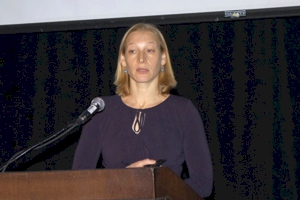Animal protein's challenging role in feeding a hungry planet
Date posted: January 11, 2017

Sandra Vijn
Canada's pork industry got a hard lesson from an industry outsider in the reality of feeding a hungry world and suggestions on how they can do it better.
"We'll need to produce more food in the next 40 years than we have in the last 8,000 years," Sandra Vijn, director, sustainable food for the World Wildlife Fund told the 2017 Banff Pork Seminar in Banff, Alta.
Animal agriculture will need to bring its use of resources and impacts in line with the earth's finite capacity and to demonstrate to consumers how their products can be part of sustainable diets. The pressure to do things differently will increase, she says.
The harsh numbers
Of all human activity, producing food has the single largest impact on our planet, says Vijn. Food production accounts for about 40 percent of the habitable land, 70 percent of water consumption and 30 percent of the greenhouse gas emissions globally. It's a leading contributor to climate change, soil erosion and the loss of biodiversity in vital ecosystems.
Livestock is the world's largest user of land resources, with pasture and land dedicated to production of feed representing almost 80 percent of the total agricultural land. Taking feed into account, it takes hundreds of gallons of water to yield a pound of meat, and livestock contribute about 14 percent of human-induced global greenhouse gas emissions.
By 2050, there will be two to three billion more people. This population growth alone will place significant pressure on our finite resources, but the greater challenge stems from coupling increased population with rising incomes. More than nine billion people will have nearly three times more income per capita and will consume twice as much as we do today.
Within the next four decades we must double net food availability, but we cannot double the amount of land in production. We must produce more with less.
Regeneration warning
Ecosystems can regenerate natural resources to produce food, fiber and fuel, but Vijn outlines how resources are being consumed at rates that cannot be replenished.
By 2050, global demand for meat is forecast to increase by 70 percent, and about 50 percent for pork. That will increase livestock's demand and competition for land, water, and feed crops.
Globally, many of today's most important crop-producing areas might not be as productive in the future. Several important aquifers on which grain agriculture depends are shrinking and precipitation patterns are changing. Soils are eroding.
"We need to intensify food production and produce more with less, not just on a per capita basis, but in absolute terms-less land, water and other resources overall than we do today if we are to live within the limitations of the planet," says Vijn. "But, we need to produce more nutrition in sustainable ways."
Ways to improve
There is no silver bullet, she says and no single strategy will solve the problem. By combining strategies we can achieve the results both we and the planet need.
"Sustainability is a precompetitive issue. We can work together to find solutions, share information and learn more quickly than ever before. Actions at speed and scale are needed to reduce the absolute impacts of the livestock industries globally."
Vijn offered three key ways to reach that goal.
Engaging platforms and multi-stakeholder initiatives. Consumer demand can influence food supply chains. Companies research hotspots to identify where sustainability impacts occur and are engaging their supply chains to identify opportunities to reduce impacts.
Platforms and roundtables such as the Global Roundtable for Sustainable Beef, a similar one for eggs, and numerous certification programs bring supply chain stakeholders such as retailers, brands, input suppliers, traders, institutions and producers together to identify how to measure, track and share information as well as to identify opportunities for improvement.
To ensure their efforts drive the consumption of natural resources below the earth's finite limits, companies and platforms today are agreeing on key metrics and establishing global systems to assess improvement opportunities for those involved in food production and to monitor the key impacts of food production globally.
This helps producers identify where conservation benefits can be made that make the most business sense. In this digital era, data can flow into databases for cost benefit analysis that can be shared with other stakeholders, while protecting the privacy of the data owners.
Improved production efficiency. Producers can document which practices are more efficient by measuring what matters and make the information available through information platforms to help other producers and buyers improve efficiency and productivity.
Producers can work with researchers, input providers, customers and others to share technologies and practices that can lead to more efficiency, while considering how to optimize public health and nutrition, animal welfare, and economic and environmental benefits.
Engaging consumers. Dealing with consumers is not clear cut, says Vijn. Consumers often blend environmental sustainability with other personal and public health issues that are not directly related and consumer concern about additives, chemicals and preservatives may overshadow other concerns such as the environment.
That's why it is critical that animal agriculture and environmental NGOs work together to communicate clearly about the importance of improving the environmental sustainability of food, mainly by being more transparent about how meat, poultry and dairy products are produced.
"Reaching out through social media channels, sharing stories, and engaging the public to explain how food is being produced, what is being done to improve environmental performance, and what measurable results the sector is achieving are needed to build support for targeted solutions to the most pressing environmental challenges facing food production systems."
Return to the News Release Index
